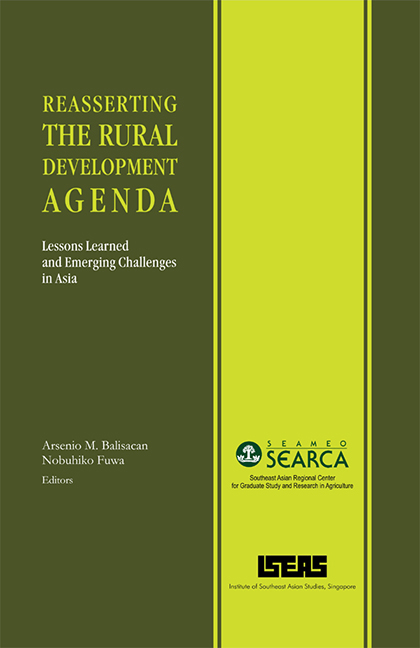Book contents
- Frontmatter
- Contents
- Tables
- Figures
- Preface
- Contributors
- 1 Challenges and Policy Options for Agricultural Development – Overview and Synthesis
- 2 The Economics of Agricultural Development: What Have We Learned?
- 3 The Role of Social Structures and Norms in Agricultural Development: Africa and East Asian Communities Compared
- 4 Food Security in a Globalised Setting
- 5 Poverty and Vulnerability
- 6 Asian Agricultural Development: From the Green Revolution to the Gene Revolution
- 7 Dryland Agriculture in Asia: Ideas, Paradigms, and Policies
- 8 Establishing Efficient Use of Water Resources in Asia
- 9 Improving the Delivery of Extension Services to Rural People: New Perspectives
- 10 Land Tenure and Forest Resource Management in Asia
- 11 Globalisation and the Poverty-Environment Link in Asian Agriculture
- 12 The Supermarket Revolution with Asian Characteristics
- Index
5 - Poverty and Vulnerability
Published online by Cambridge University Press: 21 October 2015
- Frontmatter
- Contents
- Tables
- Figures
- Preface
- Contributors
- 1 Challenges and Policy Options for Agricultural Development – Overview and Synthesis
- 2 The Economics of Agricultural Development: What Have We Learned?
- 3 The Role of Social Structures and Norms in Agricultural Development: Africa and East Asian Communities Compared
- 4 Food Security in a Globalised Setting
- 5 Poverty and Vulnerability
- 6 Asian Agricultural Development: From the Green Revolution to the Gene Revolution
- 7 Dryland Agriculture in Asia: Ideas, Paradigms, and Policies
- 8 Establishing Efficient Use of Water Resources in Asia
- 9 Improving the Delivery of Extension Services to Rural People: New Perspectives
- 10 Land Tenure and Forest Resource Management in Asia
- 11 Globalisation and the Poverty-Environment Link in Asian Agriculture
- 12 The Supermarket Revolution with Asian Characteristics
- Index
Summary
INTRODUCTION
By global standards, Asia has done remarkably well in both economic growth and poverty reduction during the past thirty years. However, this performance has not been uniform across sub-regions and countries. Indeed, even within a country, there is a typically large diversity in income growth rates and poverty reduction outcomes across household groups, locations, or socio-demographic attributes. In part, the diversity may reflect various patterns of social stratification arising from the effects of a combination of market imperfections, initial conditions, and political-economy dynamics.
In this paper, we distill not only the experiences, key research issues and findings on the nature and causes of poverty and vulnerability, but also the policy lessons emerging from the rapidly expanding literature on growth, poverty, vulnerability, and inequality in Asia. Our focus is on rural Asia. In Section II, we provide an overview of the vast number of macro-level studies exploring the connection between economic growth and poverty reduction. In Section III, we examine the evidence on the link between agricultural performance and poverty reduction. We then selectively review — in Sections IV and V — recent developments in micro-level studies on poverty dynamics and vulnerability. While the macro-level studies make us understand policy questions related to long-term development processes, the micro-level studies draw insights from the heterogeneity and diversity of economic agents and focus directly on behavioural mechanisms leading to poverty. We then conclude, in Section VI, with policy lessons and implications drawn from the review.
GROWTH AND POVERTY REDUCTION
Asia's gross domestic product (GDP) growth has consistently outpaced those of other regions of the world in the past thirty years. The region's economic growth rate averaged about 4.0 per cent per year, while the corresponding figures for developed countries and the world were about 2.6 per cent and 2.7 per cent, respectively. The growth accompanied a historic rapid poverty reduction, especially in East Asia and Southeast Asia. Between 1990 and 2001, the number of people living on less than a dollar a day fell by about 129 million. Poverty incidence in East Asia dropped from 31 to 12 per cent, while that in South Asia fell from 41 to 29 per cent. At these rates, the Millennium Development Goal (MDG) of halving by 2015 the proportion of people whose income falls below one dollar a day looks attainable for Asia.
- Type
- Chapter
- Information
- Reasserting the Rural Development AgendaLessons Learned and Emerging Challenges in Asia, pp. 121 - 158Publisher: ISEAS–Yusof Ishak InstitutePrint publication year: 2007

